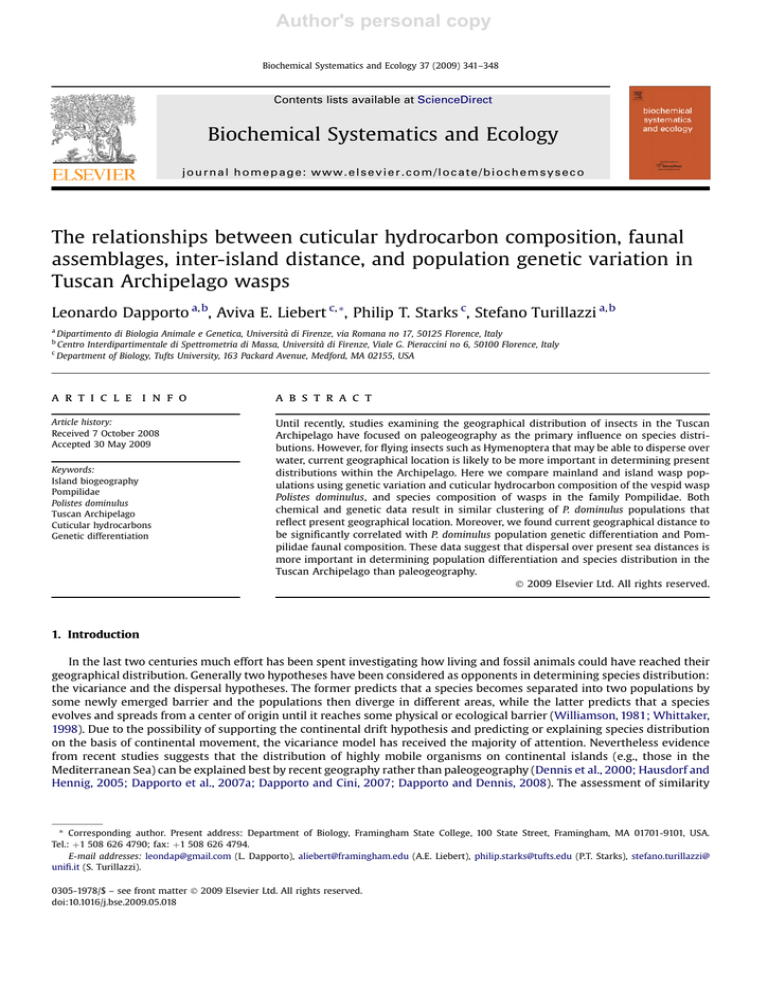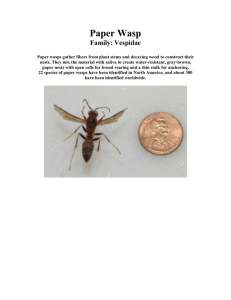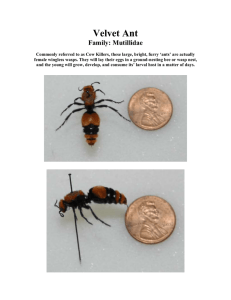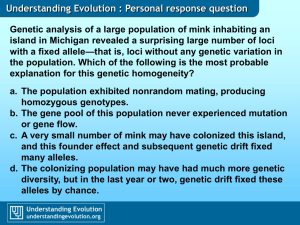
Author's personal copy
Biochemical Systematics and Ecology 37 (2009) 341–348
Contents lists available at ScienceDirect
Biochemical Systematics and Ecology
journal homepage: www.elsevier.com/locate/biochemsyseco
The relationships between cuticular hydrocarbon composition, faunal
assemblages, inter-island distance, and population genetic variation in
Tuscan Archipelago wasps
Leonardo Dapporto a, b, Aviva E. Liebert c, *, Philip T. Starks c, Stefano Turillazzi a, b
a
Dipartimento di Biologia Animale e Genetica, Università di Firenze, via Romana no 17, 50125 Florence, Italy
Centro Interdipartimentale di Spettrometria di Massa, Università di Firenze, Viale G. Pieraccini no 6, 50100 Florence, Italy
c
Department of Biology, Tufts University, 163 Packard Avenue, Medford, MA 02155, USA
b
a r t i c l e i n f o
a b s t r a c t
Article history:
Received 7 October 2008
Accepted 30 May 2009
Until recently, studies examining the geographical distribution of insects in the Tuscan
Archipelago have focused on paleogeography as the primary influence on species distributions. However, for flying insects such as Hymenoptera that may be able to disperse over
water, current geographical location is likely to be more important in determining present
distributions within the Archipelago. Here we compare mainland and island wasp populations using genetic variation and cuticular hydrocarbon composition of the vespid wasp
Polistes dominulus, and species composition of wasps in the family Pompilidae. Both
chemical and genetic data result in similar clustering of P. dominulus populations that
reflect present geographical location. Moreover, we found current geographical distance to
be significantly correlated with P. dominulus population genetic differentiation and Pompilidae faunal composition. These data suggest that dispersal over present sea distances is
more important in determining population differentiation and species distribution in the
Tuscan Archipelago than paleogeography.
Ó 2009 Elsevier Ltd. All rights reserved.
Keywords:
Island biogeography
Pompilidae
Polistes dominulus
Tuscan Archipelago
Cuticular hydrocarbons
Genetic differentiation
1. Introduction
In the last two centuries much effort has been spent investigating how living and fossil animals could have reached their
geographical distribution. Generally two hypotheses have been considered as opponents in determining species distribution:
the vicariance and the dispersal hypotheses. The former predicts that a species becomes separated into two populations by
some newly emerged barrier and the populations then diverge in different areas, while the latter predicts that a species
evolves and spreads from a center of origin until it reaches some physical or ecological barrier (Williamson, 1981; Whittaker,
1998). Due to the possibility of supporting the continental drift hypothesis and predicting or explaining species distribution
on the basis of continental movement, the vicariance model has received the majority of attention. Nevertheless evidence
from recent studies suggests that the distribution of highly mobile organisms on continental islands (e.g., those in the
Mediterranean Sea) can be explained best by recent geography rather than paleogeography (Dennis et al., 2000; Hausdorf and
Hennig, 2005; Dapporto et al., 2007a; Dapporto and Cini, 2007; Dapporto and Dennis, 2008). The assessment of similarity
* Corresponding author. Present address: Department of Biology, Framingham State College, 100 State Street, Framingham, MA 01701-9101, USA.
Tel.: þ1 508 626 4790; fax: þ1 508 626 4794.
E-mail addresses: leondap@gmail.com (L. Dapporto), aliebert@framingham.edu (A.E. Liebert), philip.starks@tufts.edu (P.T. Starks), stefano.turillazzi@
unifi.it (S. Turillazzi).
0305-1978/$ – see front matter Ó 2009 Elsevier Ltd. All rights reserved.
doi:10.1016/j.bse.2009.05.018
Author's personal copy
342
L. Dapporto et al. / Biochemical Systematics and Ecology 37 (2009) 341–348
patterns among biota of different areas, and thus implicitly their current and past relationships, may be revealed by using
several techniques. The most widely used are i) the comparison of whole faunal assemblages and ii) the analysis of similarities
among populations of few or single selected taxa based on morphological and genetic traits (Whittaker, 1998; Humphries and
Parenti, 1999; Gillespie, 2004; Hausdorf and Hennig, 2005; Heaney, 2007; Schmitt, 2007; Dapporto and Dennis, 2009).
Recently, Dapporto et al. (2004) utilized a different character to study biogeographic patterns. They used as a comparative
character the highly informative cuticular hydrocarbon (CHC) composition of different populations of Polistes dominulus to
study the biogeographical patterns of the Tuscan Archipelago. The complex cuticular blend of this species is affected by both
genetic and environmental factors (Singer et al., 1998; Dani et al., 2004; Dani, 2006; Dapporto et al., 2007b). Cuticular
hydrocarbons may thus give information about the relationships among populations and about a large spectra of environmental factors in the considered areas (substrate, climate, floral and prey composition). A combined examination of genetic
variability and CHCs among island populations would help determine the relative importance of habitat and heritability in
determining the composition of cuticular lipids and reinforce its reliability as a tool for testing biogeographical hypotheses. In
this paper we compare variation in allele frequencies, CHC composition of P. dominulus populations, and faunistic composition of Pompilidae wasps, in order to determine if historical or contemporary factors influenced the distribution of wasps
among islands, and thus the composition of their CHCs.
2. Methods
2.1. Study area
Tuscan Archipelago consists of seven main islands ranging in size from Gorgona (2.2 km2) to Elba (223.5 km2) (Fig. 1). The
islands have different lithology and geological origins. Gorgona is characterized by two different metamorphic units (sedimentary and ophiolitic). The volcanic island of Capraia originated approximately nine million years ago, after a series of
eruptions. Montecristo is a plutonic granite massif about seven million years old (Borsi et al., 1967), as is almost the entire
Giglio Island. Elba is mountainous in its western part, with the granite massif of Mt. Capanne (the highest peak of the
Archipelago, 1018 m), whereas in the eastern part, gneiss and marble emerge; the plains of the central area, densely populated, are alluvial made up of clay, sandstone, and limestone. The origin of Pianosa is different again: it consists of sedimentary
rocks and shell formations.
The climate of the Tuscan Archipelago is typically Mediterranean. The climax vegetation type was probably the oak
(Quercus ilex) forests, which are now drastically reduced in scattered patches. The present-day dominant vegetation types
throughout the islands are Mediterranean shrubs, garigue, and anthropic landscape and vegetation.
Fig. 1. The studied area. Monte Nerone, not included in the map, is located about 160 Km North-East of Venturina.
Author's personal copy
L. Dapporto et al. / Biochemical Systematics and Ecology 37 (2009) 341–348
343
2.2. Sample collection
We collected 89 females of P. dominulus from different localities, all at sea level and within two kilometers of the coast on
Corsica Island (La Marana, n ¼ 14; Bacugnana, n ¼ 10), Elba Island (Procchio, n ¼ 2, Capoliveri, n ¼ 2), Giglio Island (Castello,
n ¼ 10), Capraia Island (Isola, n ¼ 8), Pianosa Island (n ¼ 7), Gorgona Island (n ¼ 15) and Tuscany (Venturina, n ¼ 7) (Uccellina,
n ¼ 4), (Monte Nerone, n ¼ 6). All these localities share similar environmental characteristics (Mediterranean bushes).
In order to limit the influence of parameters such as colony, sex, rank, and caste, we collected flying females from the
second half of June to the end of July 2003. In this species it is not easy to distinguish nest-founding females (foundresses)
from workers, but catching flying females in the restricted period ensures a high probability of collecting only workers.
2.3. Chemical sampling
Chemical data were obtained from a subset of the collected samples: Corsica Island (La Marana, n ¼ 3; Bacugnana, n ¼ 2),
Elba Island (Procchio, n ¼ 2, Capoliveri, n ¼ 2), Giglio Island (Castello, n ¼ 5), Pianosa Island (n ¼ 6), Gorgona Island (n ¼ 5),
Capraia Island (n ¼ 6), (Venturina, n ¼ 5), (Uccellina, n ¼ 4). Peak areas of the epicuticular gas-chromatogram of each wasp
were transformed into percentages of the total CHCs. We calculated a dissimilarity matrix among the cuticular profiles of the
wasps using squared Euclidian distances (Z-scores were used to standardize the percentages). To visualize the pattern of
proximity between wasp chemical profiles we used a cluster analysis (Ward’s method). We also calculated a dissimilarity
matrix among the localities for which we had data on CHCs, genetics, and Pompilidae fauna (Corsica, Capraia, Gorgona, Elba,
Giglio, Pianosa, and Uccellina in the Tuscan mainland), by calculating the mean dissimilarity among all the possible wasp pairs
for each pair of localities. We sampled CHCs using a method similar to that described by Turillazzi et al. (1998). A piece of filter
paper was gently rubbed on the wasp’s thoracic scutum for 30 s using sterile forceps. Thereafter, the filter paper was placed in
an aluminum sheet and then in a sterile vial. The epicuticular compounds were later extracted from the filter paper in 300 ml
of pentane for 10 min. The solution was then dried in a nitrogen stream and re-eluted in 25 ml of heptane for GC–MS analysis.
We injected 2 ml of solution into a Hewlett Packard (Palo Alto, CA) 5890A gas chromatograph coupled with an HP 5971A mass
selective detector. A fused silica capillary column coated with 5% diphenyl–95% dimethyl polysiloxane (Rtx-5MS,
30 m 0.25 mm 0.5 mm; Restek, Bellefonte, PA) was used in the GC analysis. The injector port and transfer line were set at
280 C and the carrier gas was helium (at 12 psi). The temperature protocol was: 70–150 C at a rate of 30 C/min (held for
5 min), and 150–310 C at 5 C/min (held for 11.3 min). Analyses were performed in splitless mode. Identification of cuticular
compounds was performed on the basis of their mass spectra produced by electron impact ionisation (70 eV).
2.4. Microsatellite genotyping
After CHC sampling, individual wasps were shipped in 70–100% ethanol to the International Social Insect Research Facility
at Tufts University, Medford, Massachusetts, USA where they were stored at 80 C until further analysis. Microsatellite
genotyping protocols were the same as in Liebert et al. (2006). We isolated genomic DNA from two legs per wasp by grinding
the frozen tissue with sterile minipestles (Strassmann et al., 1996), then incubating the samples in 250 ml of a 5% ChelexÒ
solution (Crozier et al., 1999, modified slightly from Walsh et al., 1991). We then amplified the DNA of each wasp at six
microsatellite loci using primers developed for this species (Henshaw, 2000: Pdom1CAG, Pdom2AAG, Pdom25AAG, Pdom122AAT, Pdom127bAAT, and Pdom140TAG; Table 1). Finally, alleles were visualized on 6.5% denaturing polyacrylamide gels
using a LI-COR single channel 4200 NEN Global Edition IR2 DNA Analyzer and scored with SAGAGT 2.1 software.
2.5. Genetic data analysis
The computer program Genepop on the Web (Raymond and Rousset, 1995: http://genepop.curtin.edu.au) was used first to
confirm that the allele frequencies of each population were consistent with expectations for Hardy–Weinberg equilibrium, to
test for linkage disequilibrium, and to calculate FST, a measure of genetic differentiation between populations. The program
MicroChecker (Van Oosterhout et al., 2004: http://www.microchecker.hull.ac.uk) was used to check for evidence of null
alleles and large allele dropout. We then used four programs within the PHYLIP analysis package (Felsenstein, 2005) to
generate a consensus neighbor-joining tree of the sampled populations based on their microsatellite allele frequencies. To do
Table 1
Microsatellite loci used for genetic analysis.
Locus
Total no. of alleles
Mean expected % heterozygotes
Pdom1CAG
Pdom2AAG
Pdom25AAG
Pdom122AAT
Pdom127bAAT
Pdom140TAG
9
7
7
28
20
18
0.572
0.544
0.623
0.824
0.846
0.744
Author's personal copy
344
L. Dapporto et al. / Biochemical Systematics and Ecology 37 (2009) 341–348
this we first used the program SEQBOOT to generate 1000 replicate datasets using the bootstrapping method, and then used
GENDIST to calculate genetic distances (Cavalli-Sforza’s chord distance) between all the replicate populations. To generate
a tree, we first used the program NEIGHBOR to create neighbor-joining trees from the previously generated distance data, and
then used CONSENSE to build a consensus tree. Branch lengths were specified according to the PHYLIP documentation files by
using the program FITCH with computed distances between populations as input data. Finally, the program TreeIllustrator
Version 0.5 (Trooskens et al., 2005; http://nexus.ugent.be/geert/index.php) was used to draw the resulting tree.
2.6. Geographic distance calculation
We compiled a matrix incorporating the shortest over water distances connecting each pair of localities. The choice to use
over water distances instead of direct distances is due to the fact that animals typically disperse faster through the land
compared to sea (Hausdorf and Hennig, 2005).
The possible correlations among the four matrices created as described above (Chemical dissimilarity, genetic differentiation, Pompilidae faunal similarity, and geographic distance) were assessed with a Mantel test using Matman 1.0 program
(we used 1000 permutations and Spearman Rho).
3. Results
15
10
Fig. 2. Cluster analysis of the individuals from the different localities.
Capraia1
Capraia5
Gorgona5
Capraia2
Corsica1
Gorgona4
Gorgona2
Corsica2
Corsica3
Gorgona1
Capraia2
Gorgona3
Capraia6
Capraia3
Elba3
Elba4
Capraia5
Corsica5
Venturina3
Uccellina1
Pianosa1
Pianosa2
Venturina4
Elba1
Elba2
Venturina2
Pianosa3
Uccellina3
Uccellina4
Venturina5
Pianosa6
Venturina1
Pianosa4
Giglio2
Giglio3
Giglio4
Pianosa5
5
0
Giglio5
Giglio1
Linkage distance
20
25
For the chemical analysis, we detected a total of 35 peaks representing one or more compounds. The chemical composition
reflects the results of Dapporto et al. (2004). Cluster analysis, performed on the percentages of compound peak areas,
separated chemical profiles into two distinct blocks. The first block included Elba, Giglio, Pianosa, Uccellina and Venturina
cuticular signatures, while the second block included Corsica, Capraia, and Gorgona. Except for Giglio wasps, within each
block individuals from the same locality did not cluster together and, consequently, no well-defined subgroups emerged
(Fig. 2).
Genetic analysis showed a very similar pattern. Wasps from Corsica clustered together with wasps from Gorgona and
Capraia in 910 of 1000 trees, while the other islands showed a greater similarity with Italian mainland wasps (Fig. 3; Table 2).
Mantel test results showed a correlation between CHC dissimilarity and genetic differentiation (FST) matrices among populations (Spearman Rhorw ¼ 0.437, P ¼ 0.036). CHC dissimilarity was also correlated to Pompilidae fauna similarity obtained
Author's personal copy
L. Dapporto et al. / Biochemical Systematics and Ecology 37 (2009) 341–348
345
Fig. 3. Consensus tree based on genetic distances between eight populations, generated from 1000 bootstrapped datasets of allele frequencies at six microsatellite loci. A population from Michigan, U.S.A. was used as the outgroup; Corsica-B and Corsica-M refer to Bacugnana and La Marana, respectively. Numbers
refer to the number of trees out of 1000 in which that particular division of populations occurred, and the scale bar indicates a genetic distance of 0.01.
by Dapporto et al. (2007a,b) (Spearman Rhorw ¼ 0.425, P ¼ 0.029) but not geographic distance (Spearman Rhorw ¼ 0.273,
P ¼ 0.119). Conversely, genetic differentiation was related to geographic distance (Spearman Rhorw ¼ 0.430, P ¼ 0.026; Fig. 4)
but not to Pompilidae fauna similarity (Spearman Rhorw ¼ 0.294, P ¼ 0.08). Finally, Pompilidae fauna similarity was revealed
to be related to geographic distance (Spearman Rhorw ¼ 0.425, P ¼ 0.029).
Table 2
Genetic differentiation (FST) values between populations.
Corsica-M
Capraia
Giglio
Gorgona
Elba
Pianosa
Uccelina
Venturina
Corsica-B
Corsica-M
Capraia
Giglio
Gorgona
Elba
Pianosa
Uccelina
0.0172
0.1427
0.1505
0.1671
0.0591
0.0486
0.0403
0.1144
0.0026
0.2216
0.1327
0.0376
0.1121
0.0887
0.1866
0.2994
0.1017
0.0534
0.3254
0.2535
0.2523
0.296
0.0062
0.1398
0.1387
0.043
0.1231
0.2962
0.2369
0.2394
0.0897
0.0652
0.1018
0.043
0.0807
0.0073
Author's personal copy
346
L. Dapporto et al. / Biochemical Systematics and Ecology 37 (2009) 341–348
4. Discussion
The Tuscan Archipelago is located in the Mediterranean Sea between Corsica (a large island separated from the European
continent during the Miocene) and the Italian Peninsula. Due to its position this Archipelago contains standard transitional
fauna and flora between Corsica and Italy. Consequently, many studies have been carried out in this Archipelago with the
goals of i) searching for Corsica and Sardinia endemics and ii) explaining the present distribution of animals and plants. Until
now most of these studies have focused on demonstrating support for the idea that paleogeographic events from the Miocene
to the Pleistocene sea regression were responsible for the present pattern of distribution not only of animals with limited
dispersal ability, but also of flying insects (Società Italiana di Biogeografia, 1974; Jutzeler et al., 1996; Ketmaier et al., 2003;
Strumia, 2003).
Recently, several studies have re-evaluated the importance of dispersal in shaping animal distribution in this area,
especially for the case of flying insects. Specifically, Dapporto et al. (2007a), Dapporto and Cini (2007), Dapporto and Dennis
(2008), Fattorini (2009) demonstrated that present-day determinants shape butterfly and Hymenoptera richness and
composition in the Italian islets as well as in the Tuscan Archipelago. Accordingly, our data suggest that current sea distances
between Tuscan Archipelago populations, and therefore dispersal ability, is largely responsible for the P. dominulus genetic
variation and Pompilidae species composition. This is clearly demonstrated by the Mantel tests showing significant genetic
isolation by geographical distance for P. dominulus (Fig. 4) and the significant correlation of Pompilidae species composition
and geographical distance. Interestingly, the clustering of populations into two main blocks (Capraia–Corsica–Gorgona and
Pianosa–Elba–Giglio–mainland Tuscany) is found in three different kinds of analyses: allele frequencies (Fig. 3), CHC
composition (Fig. 2), and faunal similarity in Pompilidae species (Dapporto et al., 2007a). The influence of contemporary
distances in determining species assemblages has been recently demonstrated in some flying solitary insects in the Mediterranean (Pompilidae and Chrysididae wasps: Dapporto et al., 2007a; Fattorini, 2009; butterflies: Dennis et al., 2000;
Hausdorf and Hennig, 2005; Dapporto and Cini, 2007; Dapporto and Dennis, 2008; Fattorini, 2009). However, compared to
Pompilidae, Chrysididae and butterflies, Polistes wasps should be less prone to dispersal. Indeed it has been clearly
demonstrated that foundresses of this species (reproductive individuals) are highly philopatric and tend to remain in the
natal sites to hibernate and found new colonies (Strassmann, 1983; Starks, 2003; Dapporto and Palagi, 2006).
Recent studies also demonstrated in Sardinia, Corsica and Tuscan Archipelago that ecological parameters different from
distances and paleogeography are important determinants in shaping distributions mainly of the taxa with very low vagility
(Ketmaier et al., 2003, 2005; Dapporto and Cini, 2007; Dapporto and Dennis, 2009; Fattorini, 2009). In particular, genetic
studies have been used to verify historical and/or contemporary influences in biogeography and systematics. For the Western
Mediterranean several studies have used genetic data to verify the rotation of Sardo–Corsican plate (Caccone et al., 1994;
Ketmaier et al., 2003, 2005). This is the first attempt to verify the pattern of genetic similarity in this area by using a flying
species.
It is interesting to note that similarities among islands in Pompilidae fauna composition and P. dominulus genetic
differentiation between islands are not correlated as expected if geographical contemporary factors are the sole determinants
of these characteristics. This may be explained in part by the fact that arrival on islands is only the prerequisite for a species to
colonize an island (Williamson, 1981; Whittaker, 1998). A variety of factors, such as microclimate, substrate, specific food
requirements (prey, host plants), and competition with established species, may determine success or failure of colonization
(Whittaker, 1998). The correlation between genetic variation and CHC profiles of P. dominulus wasps also provides support for
a heritable component to CHC composition, but the lack of a strong correlation between CHC dissimilarity and geographical
distance also emphasizes the importance of environmental influences on chemical composition. Wasps feed on a wide variety
0.35
0.3
0.25
FST
0.2
0.15
0.1
0.05
0
-0.05
-0.1
0
5
10
15
20
25
30
35
40
45
Over water distance (km)
Fig. 4. Relationship between genetic differentiation among populations (FST) and geographic (over water) distance. Mantel test of increasing isolation by
distance, [one-tailed p-value ¼ 0.026 (based on 10000 permutations using Matman 1.0].
Author's personal copy
L. Dapporto et al. / Biochemical Systematics and Ecology 37 (2009) 341–348
347
of prey and plants. It has been demonstrated that insect cuticular hydrocarbons depend not only on genetic components but
also on food (Liang and Silverman, 2000). Several plants and insects on which wasps feed may have different determinants for
distribution in Tuscan Archipelago depending of their vagility and habitat requirements (Dapporto and Cini, 2007; Fattorini,
2009). Intriguingly, CHCs showed the same pattern of similarity as the genetic and faunistic data, each of which encompasses
diverse sources of information (gene flow, environmental characteristics, and historical influences). In this respect our data
seem to confirm the hypothesis made by Dapporto et al. (2004) stating that CHCs should be considered as a sort of traitd’union between genetic traits and environmental variables. Our results reinforce the idea that CHCs could represent a rapid
and valuable tool to emphasize biogeographical patterns of similarity based both on gene flow and environmental
characteristics.
Acknowledgements
This study was conducted in collaboration with the Tuscan archipelago National Park. We also wish to thank the director
and personnel of Gorgona prison for allowing us to study butterflies on the island, and the ‘‘Stazione Forestale di Follonica’’ for
making it possible to conduct research on Montecristo. The research was financed by a grant from the European INTERREG IIIII project.
We also thank an anonymous referee for improving the manuscript and Matthew Sullivan for help with the microsatellite
genotyping.
References
Borsi, S., Ferrara, G., Tongiorgi, E., 1967. Determinazione con il metodo K-Ar della età delle rocce magmatiche della Toscana. Boll. Soc. Geol. It 86, 403–410.
Caccone, A., Milinkovitch, M.C., Sbordoni, V., Powell, J.R., 1994. Molecular biogeography: using Corsica–Sardinia microplate disjunction to calibrate mitochondrial rDNA evolutionary rates in mountain newts (Euproctus). J. Evol. Biol. 7, 227–245.
Crozier, R.H., Kaufmann, B., Carew, M.E., Crozier, Y.C., 1999. Mutability of microsatellites developed for the ant Camponotus consobrinus. Mol. Ecol. 8,
271–276.
Dani, F.R., 2006. Cuticular lipids as semiochemicals in paper wasps and other social insects. Ann. Zool. Fenn. 43, 500–514.
Dani, F., Foster, K.R., Zacchi, F., Seppä, P., Massolo, A., Carelli, A., Arévalo, E., Queller, D.C., Strassmann, J.E., Turillazzi, S., 2004. Can cuticular lipids provide
sufficient information for colony nepotism in wasps? Proc. R. Soc. Lond., B 271, 745–753.
Dapporto, L., Palagi, E., Turillazzi, S., 2004. Cuticular hydrocarbons of Polistes dominulus as a biogeographic tool: a study of populations from the Tuscan
Archipelago and surrounding areas. J. Chem. Ecol. 30, 2139–2151.
Dapporto, L., Wolf, H., Strumia, F., 2007a. Recent geography determines the distribution of some flying Hymenoptera in the Tuscan Archipelago. J. Zool.
(Lond.) 272, 37–44.
Dapporto, L., Dani, F.R., Turillazzi, S., 2007b. Social dominance molds cuticular and egg chemical blends in a paper wasp. Curr. Biol. 17, r504–r505.
Dapporto, L., Palagi, E., 2006. Wasps in the shadow: looking at the pre-hibernating clusters of Polistes dominulus. Ann. Zool. Fenn. 43, 583–594.
Dapporto, L., Cini, A., 2007. Faunal patterns in Tuscan archipelago butterflies: the dominant influence is recent geography not paleogeography. Eur. J.
Entomol. 104, 497–503.
Dapporto, L., Dennis, R.L.H., 2008. Species’ richness, rarity and endemicity of Italian offshore islands: complementary signals from island-focused and
species-focused analyses. J. Biogeogr. 35, 664–674.
Dapporto, L., Dennis, R.L.H., 2009. Conservation biogeography of large Mediterranean islands. Butterfly impoverishment, conservation priorities and
inferences for an ecological island paradigm. Ecography 32, 169–179.
Dennis, R.L.H., Shreeve, T.G., Olivier, A., Coutsis, J.G., 2000. Contemporary geography dominates butterfly diversity gradients within the Aegean archipelago
(Lepidoptera: Papilionoidea, Hesperioidea). J. Biogeogr. 27, 1365–1383.
Fattorini, S., 2009. Both recent and Pleistocene geography determines animal distributional patterns in the Tuscan Archipelago. J. Zool. 277, 291–301.
Felsenstein, J., 2005. PHYLIP (Phylogeny Inference Package) Version 3.6. Distributed by the Author. Department of Genome Sciences, University of
Washington, Seattle.
Gillespie, R., 2004. Community assembly through adaptive radiation in Hawaiian spiders. Science 303, 356–359.
Hausdorf, B., Hennig, C., 2005. The influences of recent geography, paleogeography and climate in the composition of the fauna of the central Aegean
islands. Biol. J. Linn. Soc. 84, 785–795.
Heaney, L.R., 2007. Is a new paradigm emerging for oceanic island biogeography? J. Biogeog. 34, 753–757.
Henshaw, M.T., 2000. Microsatellite loci for the social wasp Polistes dominulus and their application in other polistine wasps. Mol. Ecol. 9, 2155–2234.
Humphries, C.J., Parenti, L.R., 1999. Cladistic Biogeography, second ed. Oxford University Press, Oxford.
Jutzeler, D., Biermann, H., de Bros, E., 1996. Elevage de Coenonympha corinna elbana (Staudinger, 1901) du Monte Argentario (Toscano, Italie) avec explication
géologique de l’aire de repartition de complex corinna (Lepidoptera: Nymphalidae, Satyrinae). Linn. Belg. 15, 332–347.
Ketmaier, V., Argano, R., Caccone, A., 2003. Phylogeography and molecular rates of subterranean aquatic Stenasellid Isopods with a peri-Tyrrhenian
distribution. Mol. Ecol. 12, 547–555.
Ketmaier, V., Giusti, F., Caccone, A., 2005. Molecular phylogeny and historical biogeography of the land snail genus Solatopupa (Pulmonata) in the periTyrrhenian area. Molec. Phylogenet. Evol. 39, 439–451.
Liang, D., Silverman, J., 2000. You are what you eat: diet modifies cuticular hydrocarbons and nestmate recognition in the Argentine ant, Linepithema humile.
Naturwissenschaften 87, 412–416.
Liebert, A.E., Gamboa, G.J., Stamp, N.E., Curtis, T.R., Monnet, K.M., Turillazzi, S., Starks, P.T., 2006. Genetics, behavior and ecology of a paper wasp invasion:
Polistes dominulus in North America. Ann. Zool. Fenn. 43, 595–624.
Raymond, M., Rousset, F., 1995. GENEPOP (version 1.2): population genetics software for exact tests and ecumenicism. J. Hered. 86, 248–249.
Schmitt, T., 2007. Molecular biogeography of europe: pleistocene cycles and postglacial trends. Front. Zool. 4, 11.
Singer, T.L., Espelie, K.E., Gamboa, G.J., 1998. Nest and nestmate discrimination in independent-founding paper wasps. In: Vander Meer, R.K., Breed, M.D.,
Winston, M.L., Espelie, K.E. (Eds.), Pheromone Communication in Social Insects. Westview Press, Oxford.
Società Italiana di Biogeografia, 1974. Il popolamento animale e vegetale dell’Arcipelago toscano. Lavori della Società Italiana di Biogeografia 5.
Starks, P.T., 2003. Natal nest discrimination in the paper wasp, Polistes dominulus. Ann. Zool. Fenn. 40, 53–60.
Strassmann, J.E., 1983. Nest fidelity and group size among foundresses of Polistes annularis (Hymenoptera: Vespidae). J. Kans. Entomol. Soc. 54, 621–634.
Strassmann, J.E., Solı́s, C.R., Peters, J.M., Queller, D.C., 1996. Strategies for finding and using highly polymorphic DNA microsatellite loci for studies of genetic
relatedness and pedigrees. In: Ferraris, J., Palumbi, S.R. (Eds.), Molecular Zoology. Wiley, New York, pp. 163–180.
Strumia, F., 2003. New and rare Hedychridium species from Italy and Mediterranean islands (Hymenoptera, Chrysididae). Ital. J. Zool. 70, 191–198.
Author's personal copy
348
L. Dapporto et al. / Biochemical Systematics and Ecology 37 (2009) 341–348
Trooskens, G., De Beule, D., Decouttere, F., Van Criekinge, W., 2005. Phylogenetic trees: visualizing, customizing and detecting incongruence. Bioinformatics
21, 3801–3802.
Turillazzi, S., Sledge, M.F., Moneti, G., 1998. Use of a simple method for sampling cuticular hydrocarbons from live social wasps. Ethol. Ecol. Evol. 10,
293–297.
Van Oosterhout, C., Hutchinson, W.F., Wills, D.P.M., Shipley, P., 2004. Micro-Checker: software for identifying and correcting genotyping errors in microsatellite data. Mol. Ecol. Notes 4, 535–538.
Walsh, S., Metzger, D.A., Higuchi, R., 1991. ChelexR 100 as a medium for simple extraction of DNA for PCR-based typing from forensic material. BioTechniques
10, 506–513.
Whittaker, R.J., 1998. Island Biogeography: Ecology, Evolution, and Conservation. Oxford University Press, Oxford.
Williamson, M.H., 1981. Island Populations. Oxford University Press, Oxford.






